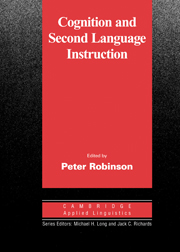Book contents
- Frontmatter
- Contents
- Series editors' preface
- Preface
- SECTION I THEORETICAL ISSUES
- 1 Attention
- 2 Memory for language
- 3 The competition model: the input, the context, and the brain
- 4 Sentence processing
- 5 Automaticity and automatization
- 6 Learnability and second language acquisition theory
- SECTION II COGNITION AND INSTRUCTION
- References
- Index
2 - Memory for language
Published online by Cambridge University Press: 05 October 2012
- Frontmatter
- Contents
- Series editors' preface
- Preface
- SECTION I THEORETICAL ISSUES
- 1 Attention
- 2 Memory for language
- 3 The competition model: the input, the context, and the brain
- 4 Sentence processing
- 5 Automaticity and automatization
- 6 Learnability and second language acquisition theory
- SECTION II COGNITION AND INSTRUCTION
- References
- Index
Summary
Working memory
Consider the flow of your conscious experience. At any point in time you may choose to focus your attention on (i) the speech of your conversation-partner, (ii) a section of conversation which you've recreated in your mind's speech from information previously stored in longterm memory (LTM), (iii) a part of the visual scene before your eyes, (iv) a part of a visual scene which you have recreated in your mind's eye from information previously stored in LTM. Of course, you have potential access to a wider range of percepts and memories than these (Baddeley, 1997; Baddeley & Hitch, 1974; Gathercole & Baddeley, 1993).
Baddeley and Hitch (1974) identified three components of working memory (WM):
The central executive, or supervisory attentional system (SAS), regulates information flow within WM, allocates attention to particular input modalities or LTM systems, activates or inhibits whole sequences of activities guided by schemata or scripts, and resolves potential conflicts between ongoing schema-controlled activities. The processing resources used by the central executive are limited in capacity, and the efficiency with which the central executive can fulfil a role depends upon the other demands that are simultaneously placed upon it. We have limited attentional resources (see Schmidt, and Skehan & Foster, this volume). The central executive is supplemented by two slave systems, each specialised for the short term memory (STM) and manipulation of material within a particular domain: the phonological loop holds verbally coded information; the visuo-spatial sketchpad deals with visual and spatial material.
- Type
- Chapter
- Information
- Cognition and Second Language Instruction , pp. 33 - 68Publisher: Cambridge University PressPrint publication year: 2001
- 126
- Cited by

